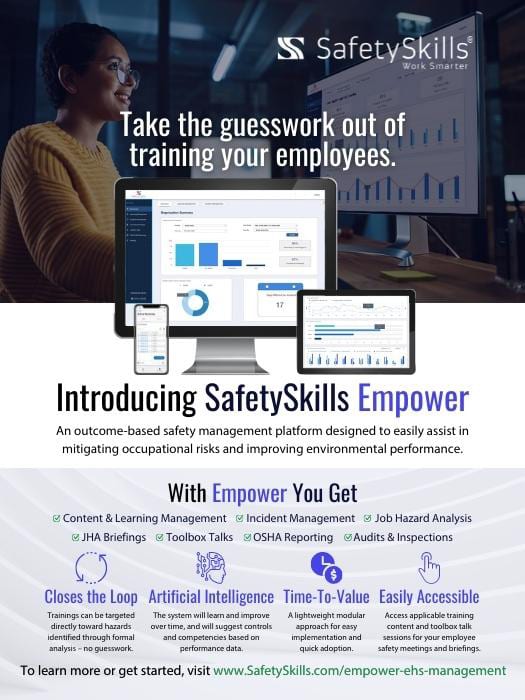Focus on
Images courtesy of Atlas Health.
Health

early intervention
A comprehensive guide to the emerging field of athletic trainers and industrial athletes
By Jack Hoffman, MAT, AT
ur bodies function and remain healthy when a basic set of principles are followed, and the way we prepare for physical tasks associated with the workplace really does matter. Workplace early intervention programs help reduce the occurrence of sprain, strain, and repetitive motion injuries in the workplace.
Workplace early intervention programs are also designed to help reduce the severity of strains and sprains when they do happen, which then speeds up recovery times. All of these factors combined, help increase workplace productivity and reduce staff turnover, which ultimately helps companies improve their bottom line.
Athletic trainers have become an increasingly important feature in occupational health settings, where they are best placed to confront and treat musculoskeletal discomfort (MSD) and any other sprain or strain injuries linked to your work.
O
What are athletic trainers?
Athletic trainers (ATs) are highly qualified, multi-skilled health care professionals who render service or treatment, under the direction of or in collaboration with a physician or physical therapist, in accordance with their education, training and the state's statutes, rules and regulations.
As a part of the health care team, services provided by athletic trainers include primary care, injury and illness prevention, wellness promotion and education, emergent care, examination and clinical diagnosis, therapeutic intervention and rehabilitation of injuries and medical conditions.
What is an industrial athlete?
Being an industrial athlete is simply an acknowledgment that the work you do daily requires you to be physical. While this concept might apply to some workers more than others, the fact remains that if the job requires you to perform any physical tasks regularly you need to start viewing yourself as an industrial athlete and not just a company employee.
Industrial athletes are usually essential frontline workers, who expose themselves to risks associated with musculoskeletal discomfort (MSD) and related soft tissue injuries. These risks cannot be avoided because industrial athletes usually perform critical tasks that benefit the communities that they serve. Examples of industrial athletes are construction workers, manufacturing employees, health workers, couriers, tractor operators, truck drivers, mine laborers, and warehouse staff.
Which industries employ athletic trainers?
According to the Bureau of Labor Statistics, the vast majority of athletic trainers work in the state, private, and local education services. A significant number of athletic trainers also work in the state, local, and private hospitals.
Beyond that, other industries that typically require the services of athletic trainers are corporate offices, construction businesses, highly repetitive jobs in manufacturing and distribution, fitness and recreation centers, public safety services, and the performing arts. These are all areas where you are forced to deal with high levels of human physical activity.
Why are athletic trainers important?
Athletic trainers provide access to qualified and immediate healthcare within the workplace.
They are important because they have extensive skills, which help address a wide range of issues impacting industrial athletes. Critically, they have a meaningful impact on the well-being of industrial athletes before an injury is sustained, during recovery from that injury, and after an industrial athlete has recovered from that work-related injury.
Athletic trainers also provide peace of mind in an occupational health setting, because they are trusted healthcare providers at your fingertips, and not office staff who have merely completed a crash course.
High-quality healthcare is not something that comes cheaply at the best of times. However, athletic trainers provide high-quality healthcare in an occupational health setting at a very affordable rate, while also mitigating and managing musculoskeletal discomfort and injury risks.
Athletic trainers provide peace of mind in an occupational health setting, because they are trusted healthcare providers at your fingertips, and not office staff who have merely completed a crash course.

How do you become an athletic trainer?
Athletic training is an academic major or graduate equivalent major program that is accredited by the Commission on Accreditation of Athletic Training Education (CAATE). The current minimum entry point into the profession of athletic training is the baccalaureate level, however it was recently decided by the AT Strategic Alliance that the minimum professional degree level will be a master's, a change to be implemented within the next several years.
Upon completion of a CAATE-accredited athletic training education program, students become eligible for national certification by successfully completing the Board of Certification, Inc. (BOC) examination.
What skills do athletic trainers have?
Athletic Trainers’ professional training education uses a competency-based approach in both the classroom and clinical settings. Using a medical-based education model, athletic training students are educated to provide comprehensive patient care in five domains of clinical practice: prevention; clinical evaluation and diagnosis; immediate and emergency care; treatment and rehabilitation; and organization and professional health and well-being.
The skills most associated with athletic trainers include rehabilitation, diagnosis, treatment planning, emergency response, orthopedics, and preventative medicine. Skills that can enhance the earning potential and employability of athletic trainers in the occupation health setting include physical therapy, case management, sports nutrition, coaching, and training program development. Beyond the technical requirements, athletic trainers are generally expected to be compassionate, detail-oriented, decisive, and able to communicate.
In addition, a complete understanding of orthopedic injuries, confident evaluation skills, basic ergonomics, with an understanding of the site's job tasks to recognize safety issues, listening and verbal communication skills, interpersonal skills, compassionate, decision making ability, critical thinking, organized, time management skills, and leadership are also important skills to hone.
What are the roles of athletic trainers?
The role of an Athletic Trainer working with in the industrial setting is very similar to one working in the traditional sports setting. In both settings, the Athletic Trainer promotes healthy lifestyle behaviors with effective education and communication to enhance wellness and minimize the risk of injury and illness.
They are trained to recognizing and evaluating injuries utilizing a systematic, evidence-based examinations, prior to implementing the appropriate plan of care. Athletic Trainers are trained in integrating best practices in immediate and emergency care for optimal outcomes, rehabilitating and reconditioning injuries.
The final verdict on an emerging field
There are currently about 30,000 athletic trainers operating in the United States, in an industry where jobs are expected to increase by 23 percent over the coming decade. It is a field that is growing much faster than most industries, which serves as recognition of the increasing significance. The Covid-19 pandemic has certainly contributed to this growth trajectory, as it lent some perspective on the importance of workplace health.
Jack Hoffman, MAT, AT, is Kraft/Heinz Onsite Solutions Provider at Atlas Injury Prevention Solutions.

